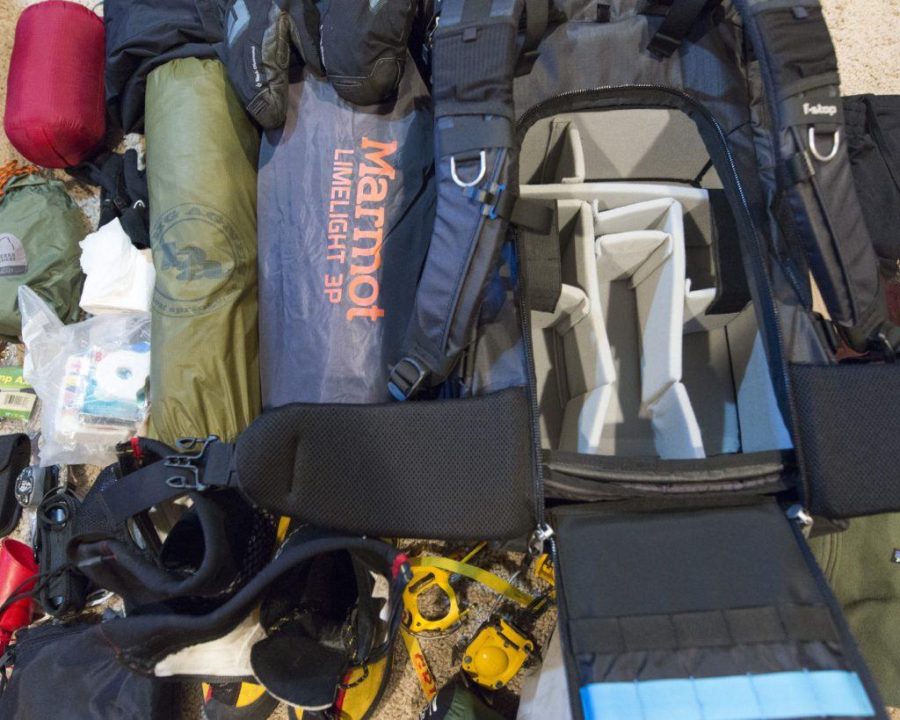You may be wondering how adventure photographers get such epic photographs. The easy-yet-complicated answer is: They take their cameras with them everywhere. Whether an adventure is high in the mountains, deep in a cave, or under the interstellar sky with the Milky Way Galaxy above, these adventure photographers have their cameras with them at all times.
This answer for getting great photographs is easy, yet complicated because adventuring with a camera is more difficult than you might think. You need to plan your gear for your adventure, as well as the camera equipment you’ll want to take, without breaking your back, or risking the safety of too much equipment. There’s a lot to take.
For instance, when you want to photograph skiing, you first have to plan out what essentials you will need to keep yourself warm. These may include glove liners, pocket warmers, extra sunglasses, and an additional layer under your coat for when you are standing still observing skiers. Next, you will need to grab some snacks and water so you do not go hungry on the slopes. Lastly, you need to bring your camera. Oh wait, what about lenses? Let’s throw some additional lenses into the mix. Don’t forget a spare battery. Since you will be in the snow for a few hours, you will also want some sort of microfiber towel to dry off the lenses to prevent water damage.
Finally, you’re packed. Now another problem appears: How do you carry your gear?
The only solution is a backpack you can rely on, at a weight you can manage, that will carry all of your gear safely. This requires significant planning ahead of time, and probably quite a bit of money.
There are many assorted styles of backpacks that photographers use, from roller bags to backpacking backpacks. The single most limiting factor preventing any adventure photographer from taking all the equipment they want is weight. You must carry the gear back and forth, and modern-day camera equipment gets heavy fast, not to mention challenging to organize.
When packing for an expedition, you should also always consider your ability to access your camera equipment. You never know when something extraordinary — like a wolf howling at a blue moon or an eagle catching a fish over a lake — is going to be in front of you. You never want to go home from an adventure saying, “I wish I had taken a photo of that.” Having an organized pack where you can easily access your camera equipment will solve this problem. The pack should also protect your gear so the falls and bumps you encounter won’t severely damage them. Camera specific bags have padding to divide lenses into compartments and they are useful for organization, too. When you don’t have padding, use your clothing. Hats, sweaters, and gloves are excellent clothing items that double as soft pads. Last but not least, make sure nothing inside your pack moves around or can fall out of a loose zipper. Dropping a lens and hearing it crack is one of the worst things a photographer can experience since those can easily cost thousands of dollars to replace.
For quick access to cameras, I like to have a CamelBak worn on my chest that houses the camera and lens. At times it does appear awkward when hiking around, but after the trip is said and done, I am very appreciative that I carry the extra pack. It also has the added benefit of letting you keep snacks and water close at hand during any outing.
As you begin packing your gear for that adventure, do some research to determine what gear to leave behind. There are various websites, like Flickr and 500PX, where you can search and take note of what lenses, ISO, focal length, and aperture other photographers used to create their stunning photos. This is a fantastic way to eliminate camera gear you can do without. Plus, when you are on your adventure, you will have a nice starting place to initialize your camera settings, from which you can make minor adjustments for the specific conditions you are in.
During your photography adventure, document what camera gear you end up using and what you do not, for both yourself and other photographers. You will also be able to write down a few essential camera settings you can use next time.
Remember, there are always going to be exceptions, but it is always better to be safe than sorry. If you feel an urge to bring a lens or filter, do so. You are the artist behind the camera; only keep in mind with extra gear comes extra weight.



